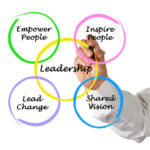
Wharton professor Michael Platt is using neuroscience to make the business case for better work culture.
During his keynote speech at the recent Wharton Neuroscience Summit, Platt shared charts, graphs, and illustrations to show what countless studies have revealed about resilience: People need a healthy dose of physical, mental, and emotional support to perform at their best. And they need real time off from work.
“Business leaders out there, why should you care? You should care deeply, and not just because it’s interesting, but because it matters for your bottom line,” Platt said to participants gathered for the summit hosted by the Wharton Neuroscience Initiative (WiN).
Resilience was the theme of the daylong meetup. For his turn at the podium, Platt, who is faculty director at WiN, deftly combined anthropology, neuroscience, business, climate change, and monkeys into a 30-minute presentation titled, “When Disaster Strikes: Resilience in Context.”
Walking the audience through a brief history of human development, Platt explained why the brain isn’t wired for the modern world. It’s made for prehistoric times, when people lived in small, close-knit groups, spent most of their lives outside, got plenty of activity, and ate natural foods.
“Time off is necessary, not just to rest but also to reconnect with your families, your friends, to engage in play, to make music, to be joyful.”— Michael Platt
“Our brains are designed for an environment 200,000 years ago. And the way our brains, our bodies, our mental health, our well-being actually play out in the current environment reflects that,” he said.
Man-made stressors are challenging enough, but natural disasters “turn up the volume knob” on trauma, he said. For 30 years, Platt has been studying a colony of rhesus macaques that live freely on Cayo Santiago, an island off Puerto Rico. Their genetics, brains, and behaviors are very similar to humans, enabling scientists to collect a range of helpful data.
The monkeys were thriving until Hurricane Maria hit as a Category 5 hurricane in 2017, killing more than 3,000 people. None of the animals perished in the storm, but the physical and emotional toll triggered premature aging that was measurable.
“The molecular landscape of their bodies is changing. This is a function of stress,” Platt explained.
Some of the monkeys fared better than others, which made scientists interested in the root cause of their resilience. They discovered that the monkeys that thrived had forged deeper social bonds and were more cooperative in the face of disaster. They became friendlier, nicer, and more tolerant. Those parts of their brains even grew bigger.
Humans can change their behavior to do the same, Platt said. To prove his point, he shared a Microsoft Labs survey that found companies with the highest employee engagement have leaders who invest in resilient cultures that support workers.
In his final message to business leaders, Platt offered a finding from a research paper he co-authored on deaths from the “epidemic of despair” in the U.S. The biggest difference between the U.S. and other industrialized countries is a dearth of paid time off.
“Time off is necessary, not just to rest but also to reconnect with your families, your friends, to engage in play, to make music, to be joyful. That’s part of the human toolkit,” he said. “And look, we just ain’t doing it, so we have to do better.”
Source: Why Taking Time Off from Work Makes You More Resilient – Knowledge at Wharton







